英文介绍翻译家尤金奈达
- 格式:ppt
- 大小:348.50 KB
- 文档页数:20

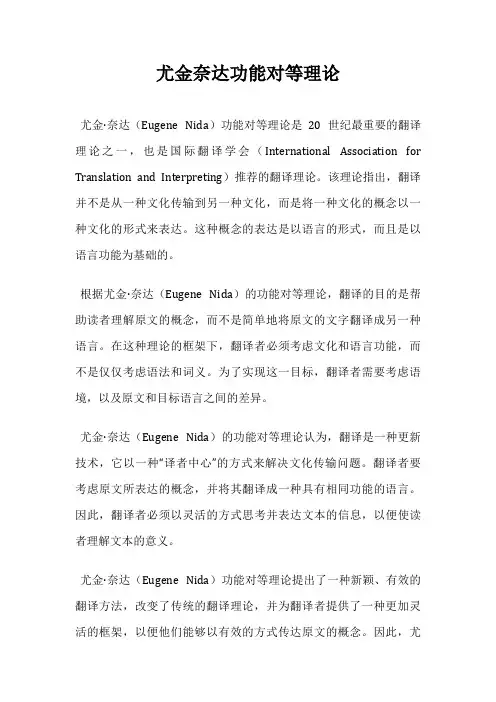
尤金奈达功能对等理论
尤金·奈达(Eugene Nida)功能对等理论是20世纪最重要的翻译理论之一,也是国际翻译学会(International Association for Translation and Interpreting)推荐的翻译理论。
该理论指出,翻译并不是从一种文化传输到另一种文化,而是将一种文化的概念以一种文化的形式来表达。
这种概念的表达是以语言的形式,而且是以语言功能为基础的。
根据尤金·奈达(Eugene Nida)的功能对等理论,翻译的目的是帮助读者理解原文的概念,而不是简单地将原文的文字翻译成另一种语言。
在这种理论的框架下,翻译者必须考虑文化和语言功能,而不是仅仅考虑语法和词义。
为了实现这一目标,翻译者需要考虑语境,以及原文和目标语言之间的差异。
尤金·奈达(Eugene Nida)的功能对等理论认为,翻译是一种更新技术,它以一种“译者中心”的方式来解决文化传输问题。
翻译者要考虑原文所表达的概念,并将其翻译成一种具有相同功能的语言。
因此,翻译者必须以灵活的方式思考并表达文本的信息,以便使读者理解文本的意义。
尤金·奈达(Eugene Nida)功能对等理论提出了一种新颖、有效的翻译方法,改变了传统的翻译理论,并为翻译者提供了一种更加灵活的框架,以便他们能够以有效的方式传达原文的概念。
因此,尤
金·奈达(Eugene Nida)功能对等理论一直是翻译研究的一个重要组成部分,在翻译实践中也得到了广泛的应用。

尤金奈达的对等理论文不灭质,博不溺心尤金·奈达(EugeneAlbertNida,1914—2011),美国当代著名翻译理论家,主要从事《圣经》的翻译和修订。
他是当代整个西方翻译理论界最具影响力的人物之一,在中国产生的影响也是有目共睹。
尤金在40岁时出版的《翻译科学探索》一书中提出了“动态对等”的概念。
所谓“动态对等”是指“译文读者对译文作出的反应与原文读者反应一致”,他为了避免理解动态对等就是强调形式上的一致,于是用“功能对等(Nida,EugeneA。
&CharlesTaberR。
1969)”替换了“动态对等”。
功能对等理论主要通过以下四个标准来指导翻译实践:(1)传达原文信息;(2)传达原作的精神和风格;(3)语言通顺、易懂;(4)目的语与源语读者反应相似。
奈达认为,译者应尽可能做到自然、切近的对等,翻译最重要的是读者对译文的反应。
功能对等包括四个方面:词汇对等、句法对等、篇章对等和文体对等。
功能对等强调翻译的读者和原文的读者反应一致。
在翻譯文本时,除了达意外,还应具有国家文化、文章情境、时代背景等深层对等。
奈达认为,译者应该始终预测目标语言接收者的理解程度和回应效果,当目标语言接收者对翻译的回应与源语言接收者对原文的回应一致时,就达到了最佳翻译效果。
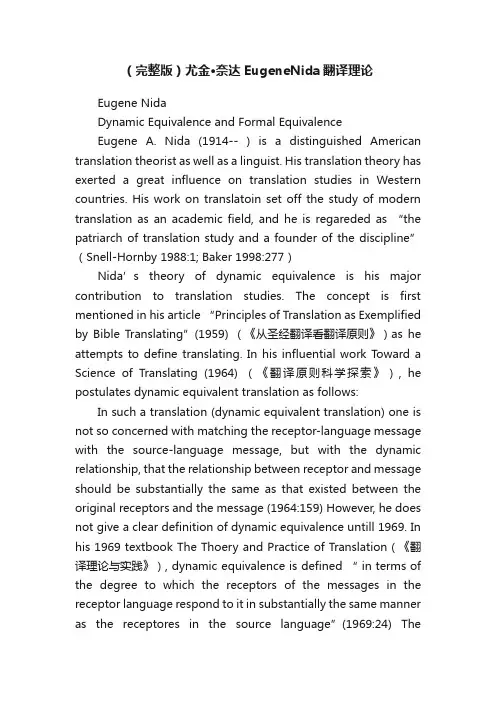
(完整版)尤金·奈达EugeneNida翻译理论Eugene NidaDynamic Equivalence and Formal EquivalenceEugene A. Nida (1914-- ) is a distinguished American translation theorist as well as a linguist. His translation theory has exerted a great influence on translation studies in Western countries. His work on translatoin set off the study of modern translation as an academic field, and he is regareded as “the patriarch of translation study and a founder of the discipline” (Snell-Hornby 1988:1; Baker 1998:277)Nida’s theory of dynamic equivalence is his major contribution to translation studies. The concept is first mentioned in his article “Principles of Translation as Exemplified by Bible Translating”(1959)(《从圣经翻译看翻译原则》)as he attempts to define translating. In his influential work Toward a Science of Translating (1964) (《翻译原则科学探索》), he postulates dynamic equivalent translation as follows: In such a translation (dynamic equivalent translation) one is not so concerned with matching the receptor-language message with the source-language message, but with the dynamic relationship, that the relationship between receptor and message should be substantially the same as that existed between the original receptors and the message (1964:159) However, he does not give a clear definition of dynamic equivalence untill 1969. In his 1969 textbook The Thoery and Practice of Translation(《翻译理论与实践》), dynamic equivalence is defined “ in terms of the degree to which the receptors of the messages in the receptor language respond to it in substantially the same manner as the receptores in the source language”(1969:24) Theexpression “dynamic equivalence” is superseded by “functional equivalencev” in his work From One Language to Another (1986, with De Waard)(《从一种语言到另一种语言》). However, there is essentially not much difference between the two concepts. The substitution of “functional equivalence” is just to stress the concept of function and to avoid misunderstandings of the term “dynamic”, which is mistaken by some persons for something in the sense of impact ( Nida 1993:124). In Language, Culture and Translating(1993)(《语言与文化:翻译中的语境》, “functional equivalence” is further divided into categories on two levels: the minimal level and the max imal level. The minimal level of “functional equivalence” is defined as “The readers of a translated text should be able to comprehend it to the point that they can conceive of how the original readers of the text must have understood and appreciated it”. The maximal level is stated as “The readers of a translated text should be able to understand and aprreciate it in essentially the same manner as the original readers did” (Nida 1993:118; 1995:224). The two definitions of equivalence reveal that the minimal level is realistic, whereas the maximal level is ieal. For Nida,good translations always lie somewhere between the two levels (Nida 19954:224). It can be noted that “functional equivalence” is a flexible concept with different degrees of adequacy. Dynamic EquivalenceA term introduced by Nida(1964) in the context of Bible translation to describe one of two basic orientations found in the process of translation (see also Formal Equivalence). Dynamic equivalence is the quality which characterizes a translation in which “the message of the original text has been so transportedinto the receptor language that the response of the receptor is essentially like that of the original receptors”(Nida & Taber 1969/1982:200, emphasis removed). In other words, a dynamically equivalent translation is one which has been produced in accordance with the threefold process of Analysis, Transfer and Restructuring (Nida & Taber 1969/1982:200); formulating such a translation will entail such procedures as substituting TL items which are more culturally appropriate for obscure ST items, making lingguistically implicit ST information explicit, and building in a certain amount of REDUNDANCY(1964:131) to aid comprehension. In a translation of this kind one is therefor not so concerne d with “matching the receptor-language message with the source-laguage”; the aim is more to “relate the receptor to modes of behavior relevant within the context of his own culture” (Nida 1964:159). Possibly the best known example of a dynamically equivalent solution to a translation problem is seen in the decision to translate the Biblical phrase “Lamb of God” into and Eskimo language as “Seal of God”: the fact that lambs are unkown in polar regions has here led to the substitution of a culturally meaningful item which shares at least some of the important features of the SL expression (see Snell-Hornby 1988/1955:15). Nida and Taber argue that a “high degree” of equivalence of response is needed for the translation to achieve its purpose, although they point out that this response can never be identical with that elicited by the original(1969/1982:24). However, they also issue a warning about the limits within which the processes associated with producing dynamic equivalence remain valid: fore example, a comparison with the broadly simialr category of Linguistic Translaton reveals that only elements which are linguisticallyimplict in TT-rather than any additional contextual information which might be necessary to a new audience—may legitimately be made explicit in TT. The notion of dynamic equivalence is of course especially relevant to Bible translation, given the particular need of Biblical translations not only to inform readers but also to present a relevant message to them and hopefully elicit a response(1969/1982:24). However, it can clearly also be applied to other genres, and indeed in many areas ( such as literary translation) it has arguably come to hold sway over other approaches (Nida 1964:160). See also Fuctional Equivalence. Further reading: Gut 1991; Nida 1964,1995: Nida & Taber 1969/1982.奈达(Nida)(1964)在《圣经》翻译中所采用的术语,用来描述翻译过程的两个基本趋向之一(另见Formal Equivalence[形式对等])。
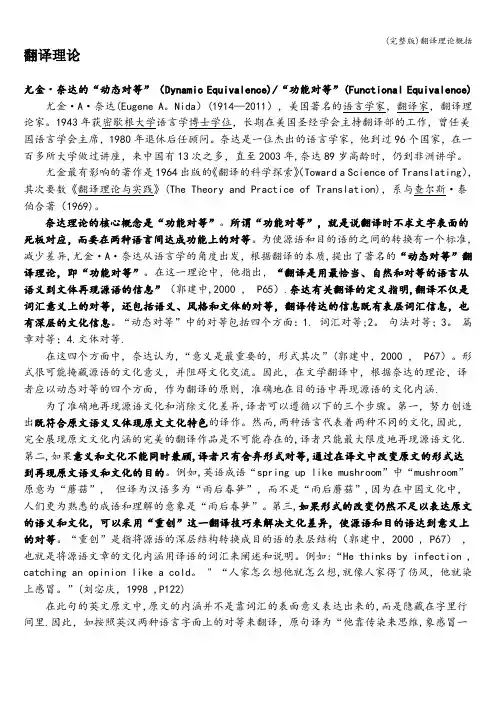
翻译理论尤金·奈达的“动态对等”(Dynamic Equivalence)/“功能对等”(Functional Equivalence)尤金·A·奈达(Eugene A。
Nida)(1914—2011),美国著名的语言学家,翻译家,翻译理论家。
1943年获密歇根大学语言学博士学位,长期在美国圣经学会主持翻译部的工作,曾任美国语言学会主席,1980年退休后任顾问。
奈达是一位杰出的语言学家,他到过96个国家,在一百多所大学做过讲座,来中国有13次之多,直至2003年,奈达89岁高龄时,仍到非洲讲学。
(Toward a Science of Translating),尤金最有影响的著作是1964出版的《翻译的科学探索》其次要数《翻译理论与实践》(The Theory and Practice of Translation),系与查尔斯·泰伯合著(1969)。
奈达理论的核心概念是“功能对等”。
所谓“功能对等”,就是说翻译时不求文字表面的死板对应,而要在两种语言间达成功能上的对等。
为使源语和目的语的之间的转换有一个标准,减少差异,尤金·A·奈达从语言学的角度出发,根据翻译的本质,提出了著名的“动态对等”翻译理论,即“功能对等”。
在这一理论中,他指出,“翻译是用最恰当、自然和对等的语言从语义到文体再现源语的信息”(郭建中,2000 , P65).奈达有关翻译的定义指明,翻译不仅是词汇意义上的对等,还包括语义、风格和文体的对等,翻译传达的信息既有表层词汇信息,也有深层的文化信息。
“动态对等”中的对等包括四个方面:1. 词汇对等;2。
句法对等;3。
篇章对等;4.文体对等.在这四个方面中,奈达认为,“意义是最重要的,形式其次”(郭建中,2000 , P67)。
形式很可能掩藏源语的文化意义,并阻碍文化交流。
因此,在文学翻译中,根据奈达的理论,译者应以动态对等的四个方面,作为翻译的原则,准确地在目的语中再现源语的文化内涵.为了准确地再现源语文化和消除文化差异,译者可以遵循以下的三个步骤。
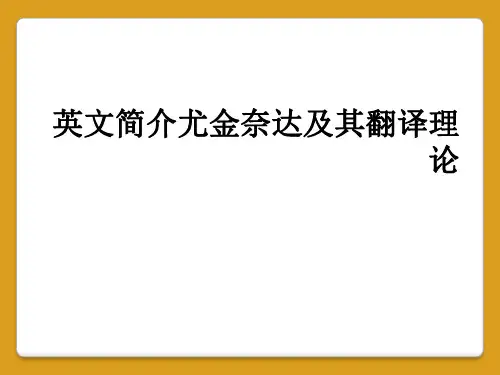
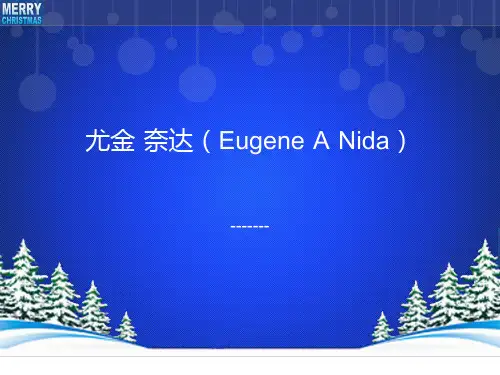

奈达翻译理论简介(一)奈达其人尤金?奈达(EugeneA.Nida)1914年出生于美国俄克勒荷马州,当代著名语言学家、翻译家和翻译理论家。
也是西方语言学派翻译理论的主要代表,被誉为西方“现代翻译理论之父”。
尤金是当代翻译理论的主要奠基人,其理论核心是功能对等。
尤金先后访问过90个国家和地区,并著书立说,单独或合作出版了40多部书,比较著名的有《翻译科学探索》、《语言与文化———翻译中的语境》等,他还发表论文250余篇,是世界译坛的一位长青学者。
他还参与过《圣经》的翻译工作。
他与塔伯合著的《翻译理论与实践》对翻译界影响颇深。
此书说明了中国与西方译界人士思维方式的巨大差别:前者是静的,崇尚“信、达、雅”,讲究“神似”,追求“化境”;后者是动的,将语言学、符号学、交际理论运用到翻译研究当中,提倡“动态对等”,注重读者反应。
中国译论多概括,可操作性不强;西方译论较具体,往往从点出发。
他在该书中提到了动态对等,详细地描述了翻译过程的三个阶段:分析、转换和重组,对于翻译实践的作用是不言而喻的。
(二)奈达对翻译的定义按照奈达的定义:“所谓翻译,是指从语义到文体(风格)在译语中用最切近而又最自然的对等语再现源语的信息。
”其中,“对等”是核心,“最切近”和“最自然”都是为寻找对等语服务的。
奈达从社会语言学和语言交际功能的观点出发,认为必须以读者的反应作为衡量译作是否正确的重要标准。
翻译要想达到预期的交际目的,必须使译文从信息内容、说话方式、文章风格、语言文化到社会因素等方面尽可能多地反映出原文的面貌。
他试图运用乔姆斯基的语言学理论建立起一套新的研究方法。
他根据转换生成语法,特别是其中有关核心句的原理,提出在语言的深层结构里进行传译的设想。
奈达提出了词的4种语义单位的概念,即词具有表述事物、事件、抽象概念和关系等功能。
这4种语义单位是“核心”,语言的表层结构就是以“核心”为基础构建的,如果能将语法结构归纳到核心层次,翻译过程就可最大限度地避免对源语的曲解。
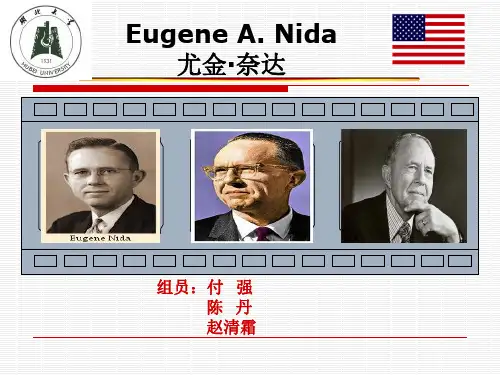
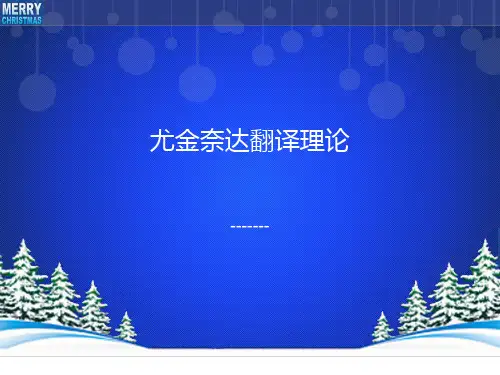
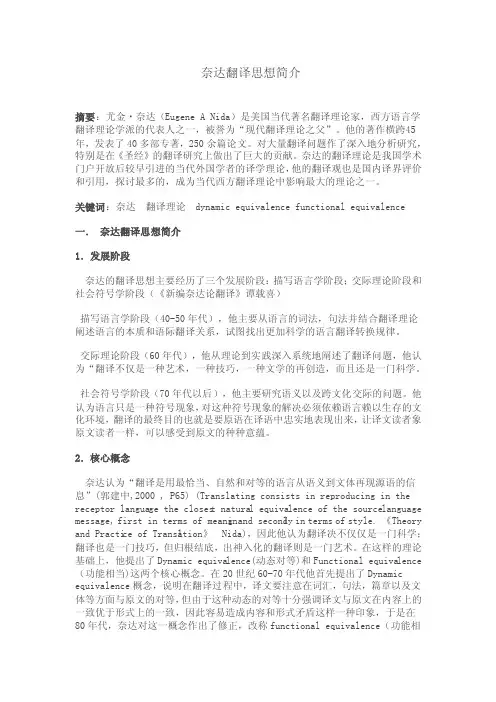
奈达翻译思想简介摘要:尤金・奈达(EugeneA Nida)是美国当代著名翻译理论家,西方语言学翻译理论学派的代表人之一,被誉为“现代翻译理论之父”。
他的著作横跨45年,发表了40多部专著,250余篇论文。
对大量翻译问题作了深入地分析研究,特别是在《圣经》的翻译研究上做出了巨大的贡献。
奈达的翻译理论是我国学术门户开放后较早引进的当代外国学者的译学理论,他的翻译观也是国内译界评价和引用,探讨最多的,成为当代西方翻译理论中影响最大的理论之一。
关键词:奈达翻译理论 dynamic equival ence functio nal equival ence一.奈达翻译思想简介1.发展阶段奈达的翻译思想主要经历了三个发展阶段:描写语言学阶段;交际理论阶段和社会符号学阶段(《新编奈达论翻译》谭载喜)描写语言学阶段(40-50年代),他主要从语言的词法,句法并结合翻译理论阐述语言的本质和语际翻译关系,试图找出更加科学的语言翻译转换规律。
交际理论阶段(60年代),他从理论到实践深入系统地阐述了翻译问题,他认为“翻译不仅是一种艺术,一种技巧,一种文学的再创造,而且还是一门科学。
社会符号学阶段(70年代以后),他主要研究语义以及跨文化交际的问题。
他认为语言只是一种符号现象,对这种符号现象的解决必须依赖语言赖以生存的文化环境,翻译的最终目的也就是要原语在译语中忠实地表现出来,让译文读者象原文读者一样,可以感受到原文的种种意蕴。
2.核心概念奈达认为“翻译是用最恰当、自然和对等的语言从语义到文体再现源语的信息”(郭建中,2000 , P65) (Transla ting consist s in reprodu cing in the recepto r languag e the closest natural equival ence of the sourcelanguag e message, first in terms of meaning and secondl y in terms of style. 《Theoryand Practic e of Transla tion》Nida),因此他认为翻译决不仅仅是一门科学;翻译也是一门技巧,但归根结底,出神入化的翻译则是一门艺术。
Functional Equivalence (功能对等)Eugene A. Nida一、奈达与“功能对等”•奈达(Eugene A.Nida)1914年出生于美国俄克勒荷马州,当代著名语言学家和翻译理论家。
尤金是当代翻译理论的主要奠基人,其理论核心是功能对等。
•尤金1943年获语言学博士学位,后长期担任美国圣经协会翻译部的执行秘书,主持翻译部工作,并曾任美国语言学会会长。
•最早的•Bible Translationg•《(圣经)翻译》•最有影响的•Toward a Science of Translating •《翻译的科学探索》1964奈达翻译思想发展的三个阶段•一、描写语言学阶段(1943-1959)•二、交际理论阶段(1959-1969)••三、社会符号学阶段(1970以后) 1.翻译是一门科学2.翻译就是交际,通信论和信息论3.动态对等翻译观4.翻译过程四步式:分析、转语、重组和检验•what is functional equivalence?•A minimal, realistic defination of functional equivalence could be stated as "The readers of a translated text should be able to comprehend it to the point that they can conceive of how the original readers of the text must have understood and appreciated it."•by Eugene A. Nida•Language,culture and translating•《语言、文化、翻译》•功能对等理论的意义?(通过什么来指导实践?)•一. 传达信息•presidential historian整体•二. 传达原作的精神和风格•来吧,朋友!•三. 语言通顺,符合译语的语法规则和表达习惯•车来了!•四. 读者反映相似•to grow like mushroomIllustration•不入虎穴,焉得虎子。
尤金·A·奈达(Eugene A.N ida),语言学家,翻译家,翻译理论家。
1914年11月11日,出生于美国俄克拉何马市。
2011年,8月25日,在西班牙马德里与世长辞,享年96岁。
1943年获密歇根大学语言学博士学位,接着长期在美国圣经学会主持翻译部的工作,曾任美国语言学会主席,1980年退休后任顾问。
奈达是一位杰出的语言学家,他到过96个国家,在一百多所大学过讲座,来中国有13次之多,直至2003年,奈达89岁高龄时,仍到非洲讲学。
编辑本段相关理论与著作这位在学术界赫赫有名的人物,偏偏远离学术重镇,默默地在美国圣经协会供职半个多世纪。
他一生的主要学术活动都围绕《圣经》翻译展开。
在《圣经》翻译的过程中,奈达从实际出发,发展出了一套自己的翻译理论,最终成为翻译研究的经典之一。
奈达著作等身,他单独或合作出版著作40多部,发表论文250馀篇,另外,还有13本专供《圣经》译者使用的参考书。
奈达的第一本专著是1946年出版的《<圣经>翻译》(Bible Translating),最有影响的是1964出版的《翻译的科学探索》(Toward a Science of Translating),其次要数《翻译理论与实践》(The Theory and Practice of Translation),系与查尔斯·泰伯合著(1969)。
奈达理论的核心概念是“功能对等”。
所谓“功能对等”,就是说翻译时不求文字表面的死板对应,而要在两种语言间达成功能上的对等。
为使源语和目的语的之间的转换有一个标准,减少差异,尤金·A·奈达从语言学的角度出发,根据翻译的本质,提出了著名的“动态对等”翻译理论,即“功能对等”。
在这一理论中,他指出,“翻译是用最恰当、自然和对等的语言从语义到文体再现源语的信息”(郭建中,2000 , P65)。
奈达有关翻译的定义指明,翻译不仅是词汇意义上的对等,还包括语义、风格和文体的对等,翻译传达的信息既有表层词汇信息,也有深层的文化信息。